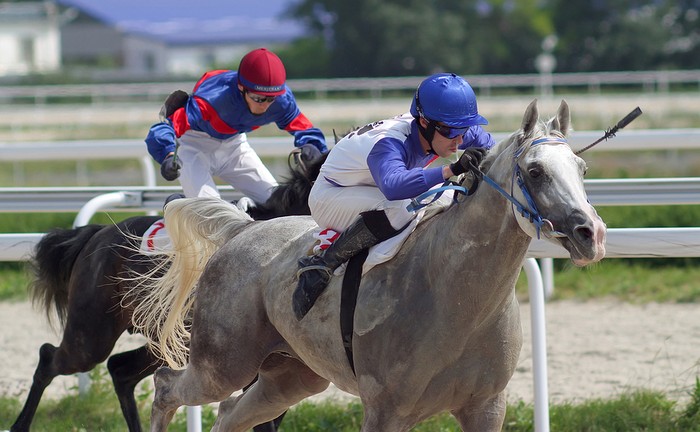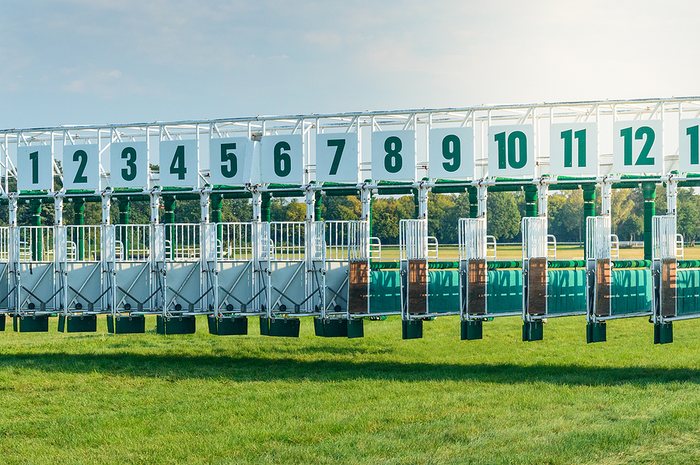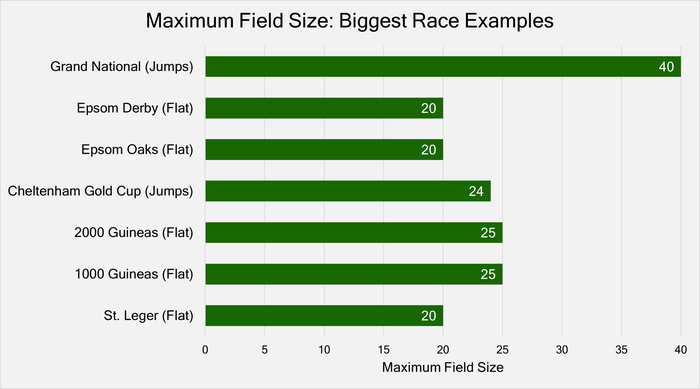 The issue of field sizes in horse racing is a regular feature in the sporting news – whether it be in regard to the overall decline in the average number of runners per race, or protests suggesting that a 40-runner maximum for the Grand National is too high.
The issue of field sizes in horse racing is a regular feature in the sporting news – whether it be in regard to the overall decline in the average number of runners per race, or protests suggesting that a 40-runner maximum for the Grand National is too high.
Other common questions among those perhaps unfamiliar with the sport are, how many horses are actually allowed to run a race? Are there minimum and maximum numbers which must be strictly adhered to? Here we look at the minimum and maximum field sizes in British horse racing, the factors determining these parameters, who decides, and more.
Minimum Field Sizes

Can a race have three runners, two …or even just one? What about a race where somehow there end up being no horses?!
Two Needed for a Competitive Race
Walk Overs aside (see below), the minimum field size for a horse race – either on the flat or over jumps – is simply the bare number of runners required to create a competitive event, i.e., two. The sport effectively began with two-horse races, with the first recorded British race, back in 1622, being a head-to-head “Match Race” for £100 between horses owned by Lord Salisbury and the Marquess of Buckingham.
Such events remained popular throughout the 17th and 18th centuries, but thankfully – from a betting and entertainment perspective – they are a rare occurrence in the modern era. These days the average number of runners tends to sit around eight.
Walk Overs
When inviting owners and trainers to enter their horses in a race, racetracks have little control over the number of runners that will ultimately be entered – with any number 0 and above being a possibility in theory. Of course, if an event fails to attract any runners at all, then the race simply won’t take place, but what happens in those instances where only one runner is declared to line up?
Whilst an extremely infrequent occurrence, this situation can occur if a race fails to attract more than one runner at the final entry stage, or, more commonly, if the field is reduced to a solitary contender via a spate of non-runners. Whenever this occurs, a process known as a Walk Over will take place.
In the event of a Walk Over, all bets are made void, and stakes are returned to punters. The remaining runner will, however, be declared the official winner of the race and collect the relevant prize money. Rather than being asked to complete the full race distance, the solitary contender need only ‘walk over’ the finish line in order to make the result official.
Maximum Field Sizes

Whilst the minimum field size is the same at all tracks and over all distances, the maximum field size varies considerably and will be related to the racecourse at which the race takes place and the distance of the race.
Every flat racecourse has a list of maximum field sizes, with each race distance having its own maximum field stipulation. The numbers are less variable at National Hunt venues, where maximum field sizes will usually be the same across the full range of distances. That said, there may be slight variations related to whether the event is a hurdle or chase and the experience of the runners taking part. For example, at some tracks, the maximum field is lower in a Novice or Maiden contest than in a standard Handicap.
With a total of 59 racecourses in the UK and the fact that races take place over a wide range of distances, there will clearly be a great deal of variety when it comes to maximum field sizes. Generally speaking, it would be rare to see a maximum field size of less than 11 on the flat and unusual for a race to have a maximum of more than 25.

Over jumps, a maximum field range of 14-25 covers most courses. Of course, there are many exceptions. The most famous of them all is the Grand National, with its huge (though reduced) maximum field of 40, but also others, such as the Wokingham Handicap at Newmarket which has a maximum field of 30.
Key Factors
The major motivating factor when determining maximum field sizes is the safety and welfare of the runners and riders taking part. Throughout the British Horseracing Authority’s (BHA) official rules of racing, the maximum field size for any given race is also referred to as its safety factor.
This safety factor is set at a level which aims to ensure that the track does not become crowded to anything approaching a dangerous level. All runners must be able to secure reasonable racing room, and not find themselves under undue pressure when rounding any bends.
The variations between different courses and over different distances will almost always be a result of one or more of the following factors:
- Width of the track – Common sense really, but in general, the wider the track, the higher the maximum field number will be. At all-weather tracks, a minimum width of 20m is the recommendation, whilst, at turf courses, this number stands at 22.9m. Tracks falling into this 20-22.9 range will usually be able to accommodate a maximum field of 16-18 runners.
- Distance to the first bend – During a race, runners need a little time to sort themselves into a pack. It is far easier to do this when running in a straight line, as opposed to attempting to establish a position when rounding a corner. The larger the field, the more troublesome bends and turns can become. The BHA, therefore, recommends a minimum distance of one furlong between the start line and the first bend. Any race which does not meet this recommendation is likely to be handed a lower maximum field allowance.
- Stable Capacity – Under the rules of British racing, all runners set to race at a meeting must have their own stable. This rule may have a direct impact on maximum field sizes. For example, whilst the dimensions of a track may accommodate a field of 30, if the track in question only has 20 stables, then the maximum field will be set at 20. If a racecourse attracts an unmanageably large number of runners over the course of a meeting, it may opt to reduce the maximum field size for one or more of the races. When deciding which runners will and won’t be allowed to run, priority is given to those with the highest official rating.
Once confirmed, the declared maximum field sizes at any track will rarely vary throughout the season, unless the width of the track needs to be adjusted due to course modifications or unsuitable patches of ground.
What Happens if the Maximum Field is Exceeded?
Whilst many races fail to attract the maximum number of runners, others draw more than the maximum field rule would allow to take part. Whenever this occurs, one of two things will happen:
- The race will take place with the maximum number of runners, with preference given to the entries with the highest official rating.
- If the number of entries exceeds the maximum field total and is also 18 or higher, the race may be split into two divisions. E.g. if a race with a maximum field stipulation of 12 attracts 18 entries, it may be split into two nine-runner events.
Who Decides Maximum Field Sizes?
Maximum field sizes are set, monitored, and regularly reviewed by the BHA’s team of course inspectors in conjunction with the clerks of the course at the individual tracks and safety officers from the Professional Jockeys Association. Each year, the PJA and the National Trainers Federation officially endorse the maximum field rules.
